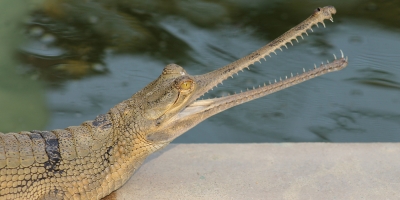
Gharials are one of the largest members of the crocodilian family. They look very similar to crocodiles and alligators, but they have a distinctive long, narrow snout, which reduces water resistance and helps them to hunt for fish. Historically, they lived in only four river systems in the world, but have now become extinct in many areas. The gharial is now listed as a Critically Endangered species. Read on to learn about the gharial.
Gharials have a typical crocodilian shape, other than their extremely elongated, narrow snouts. They are covered with smooth, non-overlapping scales. Adults are generally a dark or light-olive color, and youngsters usually have speckling and dark cross-bands on their heads, bodies, and tails. They have partly webbed fingers and toes. Like other crocodilians, they have a very thick, powerful tail, which is flattened on the sides (“laterally compressed”).
The male gharial has a large, hollow swelling at the end of his snout that is known as a “nasal boss.” This only develops when he becomes sexually mature. This swelling, and the males’ greater body-size, makes it easy to distinguish between male and female gharials (i.e. sexual dimorphism), something which is rare among other crocodilians. The function of the nasal boss is not well understood, but it might be a visual sex indicator, or it might be used as a sound resonator.
Gharials generally prefer clear, flowing, freshwater rivers with deep pools and plenty of fish. They also like habitats with sand-banks or san-bars for nesting and basking in the sun.
Gharials are found in small populations in only a few localities in the Northern part of the Indian Subcontinent.
Young gharials eat small fish, frogs, tadpoles, and insects. Adults also feed on larger fish and crustaceans. Gharials do not chew their prey, rather, they swallow it whole.
Credit : Animals.net
Picture Credit : Google




